The Butterfly effect: Monitoring at Hardknott Forest
"BUTTERFLY MONITORING AT HARDKNOTT FOREST" by Jess Wilson, Project Assistant, July 2022
One of the most exciting and rewarding things about working on the Restoring Hardknott Forest project, is being able to spend time exploring and familiarising myself with the different habitats found in the forest, and getting to know it’s varied inhabitants.
As many will know, the primary aim of the RHF project is to restore the native habitats of the site, and allow broadleaved woodland to recover through the removal of non-native species. As volunteers and the team tackle these invasive species throughout the winter months (when nesting birds will be least disturbed), in the spring and summer, we take the opportunity to carry out various biodiversity monitoring surveys to study how all our hard work is affecting the forest.
Why we monitor
Loss and degradation of habitat has been attributed as a key factor in biodiversity decline worldwide, along with overexploitation of species, introduction of invasive species, pollution and contamination. Anthropogenic activities have been held largely responsible for this.
As land-use change has a major influence on the natural environment, collecting baseline data and continued long-term monitoring of the forest, is our best way to capture and track the ecological changes on site. It allows us to measure the impacts on biodiversity over time and is also a great way for us to better understand the habitats, wildlife and ecosystems found at Hardknott.
This year, the Hardknott team decided to add butterflies to the list of species we monitor on site. Using the UK Butterfly Monitoring Scheme (UKBMS) methodology, we have been carrying out transect walks every week since the beginning of April, and will continue through the summer until September. We will then submit our data to the UKBMS. The UKBMS is one of the longest running national biodiversity recording schemes, with a wide network of professionals and volunteers contributing data annually. This wealth of data is used to research patterns and trends in butterfly populations across the UK.
So why butterflies?
Along with moths, butterflies form part of the insect order, Lepidoptera, which includes over 180,000 species worldwide. They have been studied for over 300 years and have been used extensively by ecologists to research the impact of habitat loss and climate change.
Butterflies are one of the best indicators of environmental health. They have short life-cycles and a high rate of reproduction, meaning they can respond and adapt quickly to changes in habitat and vegetation. Butterflies are often specialists, with different species preferring particular plants for food and reproduction. The Small Blue (Cupido minimus), for example, feeds solely on one plant, kidney vetch (Anthyllis vulneraria). This means that through these surveys, we can not only create an inventory butterfly species found, but also gain a better idea of the diversity of plant species at Hardknott.
In addition to what butterflies can tell us about the environment, they are also intrinsically valuable in their own right. Not only do they add colour and beauty to the landscape, they play a crucial role in maintaining a healthy ecosystem. As an important part of the food-chain, they support a wide variety of birds, bats and mammals. They are also pollinating insects and aid in the reproduction of flowering plants.
The UK has 57 native species of butterfly and 2 migrants, the Painted Lady (Vanessa cardui) and Clouded Yellow (Colias croceus). Shockingly, a recent revision of the International Union for Conservation of Nature (IUCN) Red List has named approximately 50% of UK butterfly species as threatened or near-threatened. This means that it is more crucial than ever to increase knowledge and awareness of these key ecosystem species, to better inform how we stop this loss.
The search begins
We designed our transects or “Pollard walks” (so named after the man who designed the technique), to pass through a range of habitats including regenerating and mature broadleaf woodland, conifer plantation, felled areas and our recently planted wildflower areas. As butterflies are mostly cold blooded they can’t fly in temperatures below 13°C, which means transects can only be walked on warm sunny days (oh, what a shame!).
The trickiest part of monitoring butterflies is identifying them on the wing, it can be quite frustrating when all you see is a hint of colour flutter past. Sometimes distinguishing features are very subtle, such as the case of the Pearl-bordered (Boloria euphrosyne) and Small Pearl-bordered Fritillary (Boloria selene). One thing to look out for is the white dots (or pearls) on the underwing, the Pearl-bordered has one distinct pearl in the centre, whereas the Small has three.
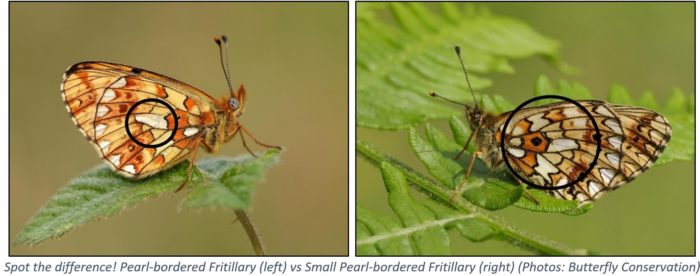
Luckily there are other factors that can help once you get your eye in. Time of year, behaviour, movement and surrounding habitat and vegetation can narrow down the options and a good identification guide is essential. I found this online guide for similar species very useful.
What we’ve found
So far (July 2022) we have identified 15 butterfly species at Hardknott,
• Small Skipper (Thymelicus sylvestris)
• Large Skipper (Ochlodes Sylvanus)
• Small White (Pieris rapae)
• Green-veined White (Pieris napi)
• Orange Tip (Anthocharis cardamines)
• Green Hairstreak (Callophrys rubi)
• Small Copper (Lycaena phlaeas)
• Common Blue (Polyommatus Icarus)
• Red Admiral (Vanessa atalanta)
• Painted Lady (Vanessa cardui)
• Small Tortoiseshell (Aglais urticae)
• Peacock (Aglais io)
• Marbled White (Melanargia galathea)
• Small Heath (Coenonympha pamphilus)
• Small Pearl-bordered Fritillary (Boloria selene)
Here’s just a few of Hardknott Forest’s colourful characters.
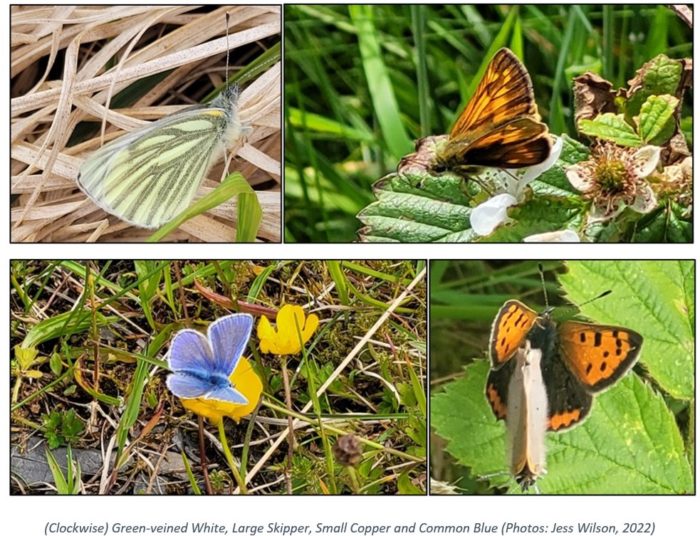
One of our most exciting finds has been the Small Pearl-bordered Fritillary. Native to the UK, this species has undergone a severe decline in England and is listed as a high priority conservation species in the UK Biodiversity Action Plan (UK BAP). It can be found in damp grassy areas, forest edges and moorland, and often feeds on bramble and thistles. The caterpillar’s main food source is Common Dog-violet (Viola riviniana) or Marsh violet (Viola palustris).
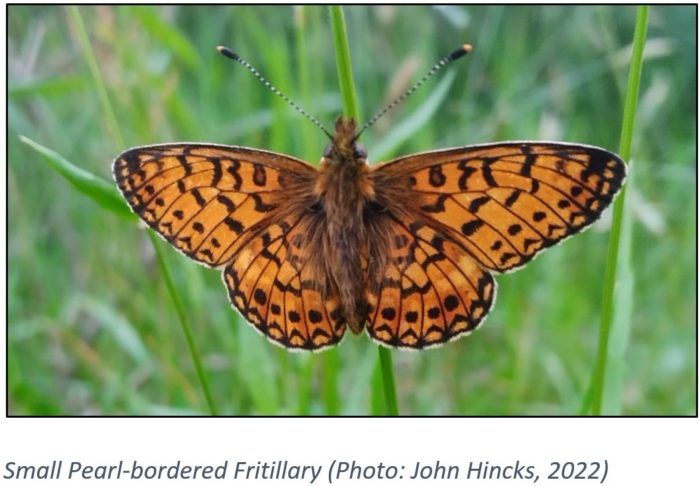
What we hope to find
According to a report produced by Butterfly Conservation on the state of Britain’s butterflies, 76% of UK butterflies have declined in abundance or distribution since 1976. This loss has been mainly driven by habitat loss and degradation, along with climate change. With this in mind there are some species we are very keen to find.
The Mountain Ringlet (Erebia epiphron) is possibly one of the oldest species of butterfly, and is our only true montane species of butterfly. As the name would suggest it is found in mountainous areas over 350m, which would make it right at home at Hardknott. Unfortunately, with the effects of climate change this specialist species is under pressure from declining suitable conditions and is registered as near-threatened by the IUCN Red List.
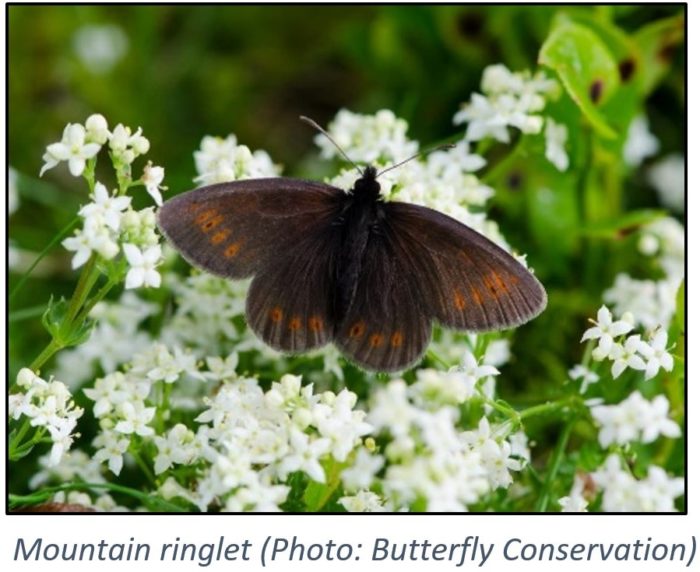
Similarly, the Scotch Argus (Erebia aethiops) occurs in upland, ungrazed grasslands, where it favours purple moor-grass (Molina caerulea) (which we have at Hardknott). Although common and widespread in Scotland, its southern range has been severely reduced. There are now only two known isolated areas in England where this species is found, and they are both in Cumbria.
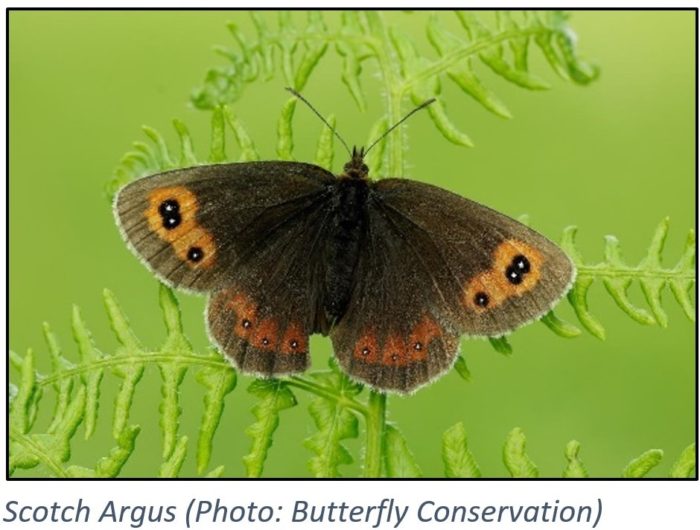
More information about Cumbria’s butterflies can be found on Butterfly Conservation’s Cumbria branch website.
What we can do to help
Thanks to help from our dedicated volunteers, we have already begun propagating and planting wildflowers at Hardknott to improve and create new habitats, concentrating on plant species that are locally native, but currently infrequent or missing from the site such as water avens (Geum rivale), sheep’s-bit (Jasione montana), devil’s-bit scabious (Succisa pratensis), globeflower (Trollius europaeus) and ragged robin (Lychnis flos-cuculi). We hope to continue to expand and improve our wildflower areas, and our Wildflower Growing Group are busy bringing on seeds now, ready for planting in autumn.

Butterfly monitoring has quickly become my favourite task at Hardknott, and I have hugely enjoyed learning more about these fascinating species. For example, did you know the collective noun for a group of butterflies is a kaleidoscope?
Here’s just a few other interesting things I’ve discovered…
• The Painted Lady is the most widely distributed butterfly in the world and undertakes a 9,000-mile round trip from Africa to the Arctic Circle in a series of steps by up to six successive generations.
• The Purple Hairstreak (Favonius quercus) is a relatively common species, restricted to oak woodlands, however it is rarely recorded as it spends most of its time up in the tree canopy.
• The Green Hairstreak is the UK’s only true green butterfly in the UK.
• The name Lepidoptera comes from the Ancient Greek, meaning scaled wing.
• There are 6 families of butterfly, Skippers (Hesperiidae), Metalmarks (Riodinidae), Gossamer-Winged (Lycaenidae), Whites and Allies (Pieridae), Brush-Footed (Nymphalidae) and Swallowtails (Papilionidae).
• Butterflies are found on every continent except Antarctica.
If you would like to learn more about butterflies, or perhaps conduct your own surveys, the Butterfly Conservation and UKBMS websites have a wealth of information and resources to get you started.
And if you’re interested in improving habitat and enjoying butterflies in your own garden, here is a list of the top 10 wildflower species to plant for butterflies.
